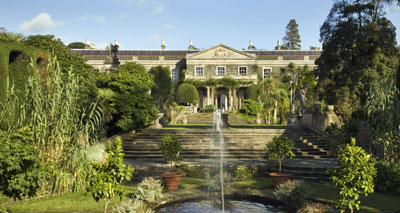 Bangor Historical Society’s last talk of 2017 took place on 14 December - John Grace gave a presentation on the architecture of Mount Stewart which he called The Cinderella House, because something kept getting in the way of it being finished.
Bangor Historical Society’s last talk of 2017 took place on 14 December - John Grace gave a presentation on the architecture of Mount Stewart which he called The Cinderella House, because something kept getting in the way of it being finished.
The story of Mount Stewart began with Alexander Stewart’s purchase of the estate in 1744. He was a very successful merchant, trading in linen and flax. He married the heiress Mary Cowan. A map of the demesne in 1779 showed a single storey house and a row of cottages on the site. This farmhouse on the present site was closer to the shore. Stewart also had houses in Newtownards and Dublin. His plans for a new house at Mount Stewart did not come to fruition. He had other expenses, including the provision of dowries for his seven daughters. There was also the expense of getting his eldest son elected to the Irish parliament. He died in 1781 and the estate was inherited by his son Robert.
The ‘Temple of the Winds’ was built 1782-5. James ‘Athenian’ Stewart based his design on a building in Greece. Robert Stewart who became the first Marquis of Londonderry planned to develop the house. He asked the architect George Dance to draw up plans. A west wing was created in 1804. Part of the original farmhouse was converted – the entrance was moved to the more sheltered north side and a porte cochere or covered entrance was added. The stone used was wacke or freestone. This can still be seen on the current building where the space between the stone is filled with mortar which includes slivers of stone. This was a cheaper option.
In 1821 another Robert inherited the title as the second Marquis. He is better known as Viscount Castlereagh, the British foreign secretary at the time of the Napoleonic Wars. He had a house in Kent and spent much of his time in London or abroad. In 1822 he committed suicide. He and his wife Lady Emily Hobart had no sons and the title and estate were inherited by his half-brother Charles.
The third Marquis was a professional soldier. His second wife was Francis Anne Vane-Tempest from Durham. The family seat was at Wynyard. Her mother was Anne, Countess of Antrim. An only child, she inherited the family property aged 13 on the death of her father. At the age of 19 she married the third Marquis who was aged 41. Her property included coal mines, a house and 10,000 acres. On a visit to Mount Stewart she said it was in a terrible state. Meanwhile money was spent elsewhere: on the rebuilding of Wynyard Hall and a property in Park Lane, London which became Londonderry House. In the early 1830s the Ordnance Survey Memoirs called Mount Stewart plain and small with large gardens. A map of 1834 showed that the house was further from the shore: land had been reclaimed from the Lough and the Portaferry Road moved further out.
More money was spent on rebuilding Wynyard following a serious fire. It was not until 1846 that large sums of money were spent on Mount Stewart. Frederick, Viscount Castlereagh, married Lady Elizabeth Powerscourt, widow of Viscount Powerscourt. He was Lord Lieutenant of County Down and spent more time at the house. Doubt surrounds the architect of the new developments. William ‘Vitrivius’ Morrison has been named, but he died in 1838. Frederick inherited the estates and the title of fourth Marquis in 1854. He also added the lake and a new stable bock and created the two storey chapel. A water colour of the 1850s shows the house much as it is today.
The next significant changes to the estate took place in the twentieth century. In 1922 the seventh Marquis and his wife Lady Edith came to live at Mount Stewart. Lady Edith created the gardens which can still be enjoyed today. Her youngest daughter Lady Mairi inherited Mount Stewart and in 1976 gifted the house to the National Trust, although the family retained a residence there. Recently the Trust has spent over £8 million on the house, including structural repairs. The central hall was repainted in a lighter colour and Lady Mairi’s black and white tiles were removed to reveal the original Scrabo stone floor. This is the only one of the family houses to remain much as it was. Londonderry House has been replaced by the London Hilton.
The chairman then thanked the speaker for a very interesting and informative talk. The society meets again in the North Down Museum on Thursday 11 January 2018 at 8pm. Stephen Cameron will talk about the Patricia Curran murder case.
